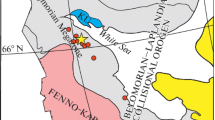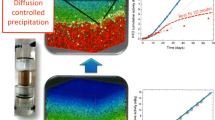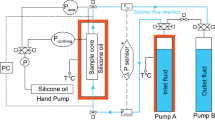Abstract
Retrograde coronas of Caledonian age, between clinopyroxene and plagioclase in the Jotun Nappe Complex, Norway, illustrate the effects of diffusion kinetics on mineral distributions among layers and on the compositions of hornblende-actinolite. One corona type comprises a symplectite of epidote + quartz adjacent to plagioclase, and a less well-organized intergrowth of amphibole + quartz replacing clinopyroxene. The observed mineral proportions imply an open-system reaction, but the similarity of Al/Si ratios in reactant plagioclase and product symplectite indicates approximate conservation of Al2O3 and SiO2. The largest inferred open-system flux is a loss of CaO, mostly derived from consumption of clinopyroxene. The approximate layer structure, Pl|Ep + Qtz|Hbl + Qtz|Act±Hbl + Qtz|Cpx, is modelled using the theory of steady-state diffusion-controlled growth with local equilibrium. To obtain a solution, it is necessary to use a reactant plagioclase composition which takes into account aluminous (epidote) inclusions. The results indicate that, in terms of Onsager diffusion coefficients L ii , Ca is more mobile than AL (L CaCa/L AlAl≳3.) (where ≳ means greater than or approximately equal to). This behaviour of Ca is comparable with that of Mg in previously studied coronas around olivine. Si is non-diffusing in the present modelling, because of silica saturation. Oxidation of some Fe2+ to Fe3+ occurs within the corona. Mg diffuses towards its source (clinopyroxene) to maintain local equilibrium. Other coronas consist of two layers, hornblende adjacent to plagioclase and zoned amphibole + quartz adjacent to clinopyroxene. In the zoned layer, actinolitic hornblende forms relict patches, separated from quartz blebs by more aluminous hornblende. A preliminary steady-state, local-equilibrium model of grain-boundary diffusion explains the formation of low-Al and high-Al layers as due to Al immobility. Zoning and replacement are qualitatively explained in terms of evolution of actinolite to more stable aluminous compositions. This is modelled by a non-steady-state modification of the theory, retaining local equilibrium in grain boundaries while relatively steep zoning profiles develop in grain interiors through slow intracrystalline diffusion. Replacement of actinolite by hornblende does not require a change in P−T conditions if actinolite is a kinetically determined, non-equilibrium product. The common preservation of a sharp contact between hornblende and actionolite layers may be explained by ineffectiveness of intracrystalline diffusion: according to the theory, given sufficient grain-boundary Al flux, a metastable actinolite + quartz layer in contact with hornblende may be diffusionally stable and may continue to grow in a steady state.
Similar content being viewed by others
References
Ashworth JR, Birdi JJ (1990) Diffusion modelling of coronas around olivine in an open system. Geochim Cosmochim Acta 54:2389–2401
Austrheim H, Robins B (1981) Reactions involving hydration of orthopyroxene in anorthosite-gabbro. Lithos 14:275–281
Battey MH, McRitchie WD (1975) The petrology of the pyroxenegranulite facies rocks of Jotunheimen, Norway. Norsk Geol Tidsskr 55:1–49
Battey MH, Davison W, Oakley PJ (1979) Almandine pseudomorphs after plagioclase in a metadolerite dyke from the Jotunheim, Norway. Mineral Mag 43:127–130
Birdi JJ (1990) Diffusive modelling of coronas in rocks from the Jotunheim, southern central Norway. PhD thesis, University of Birmingham.
Brady JB (1977) Metasomatic zones in metamorphic rocks.Geochim Cosmochim Acta 41:113–125
Bryhni I, Sturt BA (1985) Caledonides of southwestern Norway. In: Gee DG, Sturt BA (eds) The Caledonide Orogen—Scandinavia and related areas. Wiley, Chichester, pp 89–107
Emmett TF (1980a) The metamorphism and tectonic relationship between gabbros and granulites around Gjendebu, Jotunheimen, central southern Norway. PhD thesis, University of Newcastle upon Tyne
Emmett TF (1980b) The geology of the Torfinnsbu window, central Jotunheimen, Norway. Norsk Geol Tidsskr 60:255–261
Emmett TF (1982a) Structure and petrology of the Bergen-Jotun kindred rocks from the Gjendebu region, Jotunheimen, central southern Norway. Norges Geol Unders 373:1–32
Emmett TF (1982b) The petrography and geochemistry of coronabearing dolerites from the Jotun Nappe, central southern Norway. Mineral Mag 46:43–48
Emmett TF (1985) The trace element geochemistry of some highgrade Bergen-Jotun kindred gneisses from the Jotun Nappe around Gjendebu, central southern Norway. J Metamorphic Geol 3:119–136
Emmett TF (1987) A reconnaissance study of the distribution of Ba, Nb, Y and Zr in some Jotun kindred gneisses from central Jotunheimen, southern Norway. J Metamorphic Geol 5:41–50
Ferry JM (1983) Applications of the reaction progress variable in metamorphic petrology. J Petrol 24:343–376
Fisher GW (1978) Rate laws in metamorphism. Geochim Cosmochim Acta 42:1035–1050
Freer R (1981) Diffusion in silicate minerals and glasses: a data digest and guide to the literature. Contrib Mineral Petrol 76:440–454
Grant SM (1988) Diffusion models for corona formation in metagabbros from the Western Grenville Province, Canada. Contrib Mineral Petrol 98:49–63
Grapes RH, Graham CM (1978) The actinolite-hornblende series in metabasites and the so-called miscibility gap: a review. Lithos 11:85–97
Griffin WL (1971a) Genesis of coronas in anorthosites of the Upper Jotun Nappe, Indre Sogn, Norway. J Petrol 12:219–243
Griffin WL (1971b) Mineral reactions at a peridotite-gneiss contact, Jotunheimen, Norway. Mineral Mag 38:435–445
Griffin WL, Heier KS (1973) Petrological implications of some corona structures. Lithos 6:315–335
Hofmann A (1972) Chromatographic theory of infiltration metasomatism and its application to feldspars. Am J Sci 272:69–90
Hossack JR, Cooper MA (1986) Collision tectonics in the Scandinavian Caledonides. In: Coward MP, Ries AC (eds) Collision tectonics. Geol Soc Lond Spec Publ No 19, pp 287–304
Hossack J, Garton M (1982) A discussion on the Torfinnsbu Window, Jotunheimen. Norsk Geol Tidsskr 62:67–68
Isaacs AM, Brown PE, Valley JW, Essene EJ, Peacor DR (1981) An analytical electron microscopic study of a pyroxene-amphibole intergrowth. Contrib Mineral Petrol 77: 115–120
Joesten R (1977) Evolution of mineral assemblage zoning in diffusion metasomatism. Geochim Cosmochim Acta 41:649–670
Joesten R (1986) The role of magmatic reaction, diffusion and annealing in the evolution of coronitic microstructure in troctolitic gabbro from Risör, Norway. Mineral Mag 50:441–467
Johnson CD, Carlson WD (1990) The origin of olivine-plagioclase coronas in metagabbros from the Adirondack Mountains, New York. J Metamorphic Geol 8:697–717
Kretz R (1983) Symbols for rock-forming minerals. Am Mineral 68:277–279
Liou JG, Maruyama S (1987) Parageneses and compositions of amphiboles from Franciscan jadeite-glaucophane type facies series metabasites at Cazadero, California. J Metamorphic Geol 5:371–395
Maruyama S, Suzuki K, Liou JG (1983) Greenschist-amphibolite transition equilibria at low pressures. J Petrol 24:583–604
McGuire AV, Dyar MD, Ward KA (1989) Neglected Fe3+/Fe2+ ratios—a study of Fe3+ content in megacrysts from alkali basalts. Geology 17:687–690
Mongkoltip P, Ashworth JR (1986) Amphibolitization of metagabbros in the Scottish Highlands. J Metamorphic Geol 4:261–283
Murthy SRN (1973) Petrochemistry and origin of the Raudhamaren ultramafites, Jotunheimen. Norges Geol Unders 300:41–52
Nishiyama T (1983) Steady diffusion model for olivine-plagioclase corona growth. Geochim Cosmochim Acta 47:283–294
Robinson P, Spear FS, Schumacher JC, Laird J, Klein C, Evans BW, Doolan BL (1982) Phase relations of metamorphic amphiboles: natural occurrence and theory. Rev Mineral 9B:1–227
Thompson JB Jr, Laird J, Thompson AB (1982) Reactions in amphibolite, greenschist and blueschist. J Petrol 23:1–27
Trolliard G, Boudeulle M, Lardeaux JM, Potdevin JL (1988) Contrasted modes of amphibole development in coronitic metagabbros: a TEM investigation. Phys Chem Minerals 16:130–139
Author information
Authors and Affiliations
Rights and permissions
About this article
Cite this article
Ashworth, J.R., Birdi, J.J. & Emmett, T.F. Diffusion in coronas around clinopyroxene: modelling with local equilibrium and steady state, and a non-steady-state modification to account for zoned actinolite-hornblende. Contr. Mineral. and Petrol. 109, 307–325 (1992). https://doi.org/10.1007/BF00283321
Accepted:
Issue Date:
DOI: https://doi.org/10.1007/BF00283321




